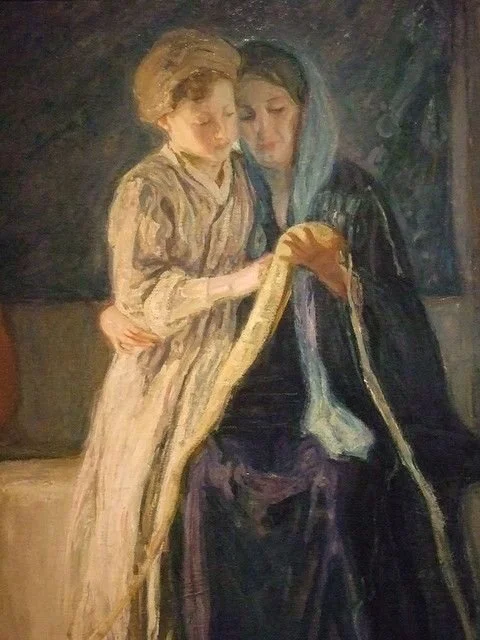Inbreaking Authority
“What is this? A new teaching: with authority!”
Henry Ossawa Tanner (1859-1937) was the first notable African American painter: a remarkable figure, one of the greats of the American fine art tradition, who sought to “preach with his brush” a Biblical imaginary at once familiar and striking. His art is attentive to subtle details neglected in the historic and mainstream tradition: the poor, the Black; women and children; the marginal — people central to the story of Scripture, yet often forgotten when the Scriptures are depicted and proclaimed. Here we see Jesus in the midst of his famous encounter with Nicodemus by night (1899), illumined by a soft, supernatural light … and clearly a man of Middle Eastern (not European) descent.
Tanner’s most famous painting is probably his 1897 painting of the Annunciation, which depicts Mary as a young Jewish peasant, peaceful ,but perplexed and concerned at this fiery irruption of light into her bedroom. The image is strange and striking: this meeting and mingling of the utterly supernal incompatible fire of divinity with the natural weight of human form and circumstance. Yet rather than the terror of apocalypse, the light appears as a gentle, even kindly glow…
Likewise, his remarkable Christ and his Mother Studying the Scriptures (1909) presents us with a paradox, and an unanswerable question. Does tender scene give us an image of Mary teaching the boy Jesus learning to read? Or is this a painting of the light of divinity shining through the vessel of her Son Jesus to illuminate her? The painting can be read either way. We are left to contemplate these moments of intimate dialogue between divinity and humanity, and ponder how God speaks to us.
Jesus appears as one teaching “with authority,” and not as the Scribes and the Pharisees. But we should not think that this “authority” means he comes giving us easy and straightforward answers. This authority, rather, is seen in how the darkness of the world flees before his footfalls, how the demons shriek and flee, how brokenness is healed, love and joy burst forth from out of nowhere, and our loneliness suddenly dissipates. We see these things happening before our very eyes … and yet, somehow, they are still an enigma to us.
The fear of the Lord is the beginning of wisdom; a good understanding have all those who live accordingly.
— Psalm 111:10
Fourth Sunday of Epiphany
Texts for this Week
Prayer
O God, you know that we are set in the midst of many grave dangers, and because of the frailty of our nature we cannot always stand upright: Grant that your strength and protection may support us in all dangers and carry us through every temptation; through Jesus Christ our Lord, who lives and reigns with you and the Holy Spirit, one God, for ever and ever.
Also Sprach Jesus
Paradoxically, although composed to dramatize the Nietzschan proclamation of the death of God, Richard Strauss's grandiose 1896 tone poem Also Sprach Zarathustra beautifully encapsulates the vibe of Christ’s authority, and the majestic yet vulnerable God we encounter in this week’s Scriptures.
The famous opening fanfare speaks like a bolt out of the blue; a bold and powerful dawning; a poised and irresistible proclamation — a “new teaching, and with authority.” Nietzsche and his fictionalized Zarathustra speak with a prophetic voice which, though the most trenchant 19th C critique of Christianity, is actually at root critique of Christianity that resonates with the fundamental spirit of Jesus. What Nietzsche took aim at was not actually the Gospel so much as the entrenched cultural and historical systems of Europe, entrenched in the trappings of a historic but hollowed Christian faith — the “scribes and Pharisees” of his day.
Of course, in the end, Nietzsche did in fact miss the ultimate paradoxical power and mystery of the Gospel, which is the fulfillment of his critique. The value of his prophetic philosophy is purely iconoclastic: it shakes our thin certainties, but it does not ultimately resolve into a holistic and satisfying way of life and being in the world, nor does it gesture towards it. In much the same way, new aural coherence that Strauss’s fanfare leads into is complex and intriguing, but it does not have the same striking swagger and authority as the first two minutes of the piece.





